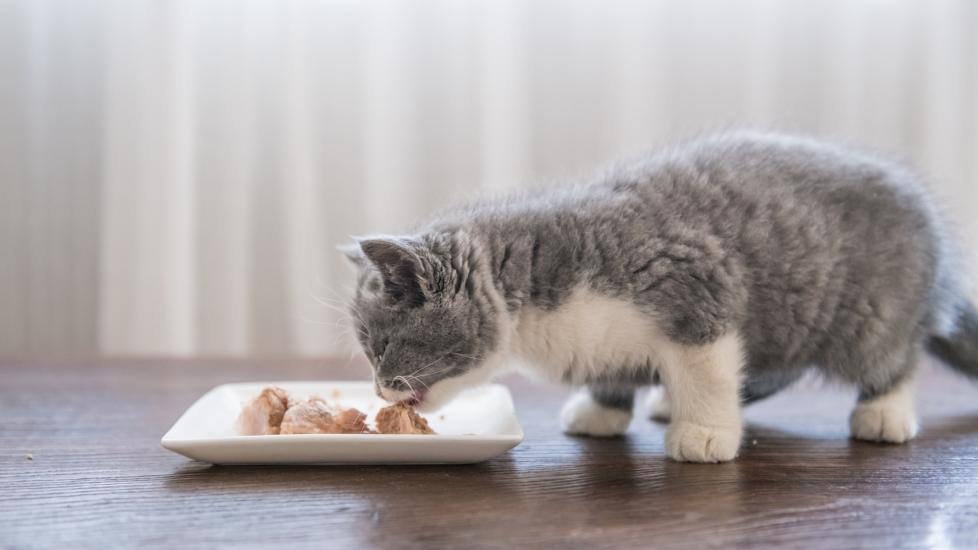Weaning Kittens: When and How To Introduce Solid Food
Whether you’re caring for a cat that’s given birth or are fostering orphaned kittens, weaning is an important part of newborn care. But how long do kittens nurse, and when are they weaned? Here’s everything you need to know about properly weaning kittens.
What Is Weaning?
Weaning refers to the process of transitioning newborn (neonate) kittens from milk (either nursing or bottle feeding) to solid food. Because kittens are no longer reliant on nursing, the weaning process also involves a kitten becoming more mobile and more independent.
When Are Kittens Weaned?
Kittens are typically ready to be weaned at about 4 weeks of age, but some are ready for solid food at as early as 3 weeks old. You’ll know a kitten is ready to be weaned when they:
-
Become more mobile
-
Have deciduous (baby teeth) canines and incisors
-
Are becoming more curious and playful
-
Are starting to show interest in their mom’s solid food
How To Wean Kittens Step-By-Step
It’s important to follow the proper process when your kitten is ready to be weaned.
1. Find the Right Food
Be sure your kitten is transitioning to a complete and balanced diet specifically formulated for growing kittens. This means there should be a statement from the Association of American Feed Control Officials (AAFCO) confirming the diet meets the established nutritional requirements for a growing kitten.
The weaning process typically begins with a commercial canned kitten food. Eventually, you can transition to a commercial dry kitten food or kibble.
2. Briefly Separate the Kitten From Mom
If you are weaning kittens directly from their mother, it can help to keep them separated for short bursts of time so the kittens are encouraged to become more independent. The intervals should last up to an hour and be around feeding times. Most mother cats can complete the weaning process on their own, but progressive breaks from her kittens can help.
Always be sure to have food, water, and a litter box available for both Mom and her kittens. Do not completely remove kittens from their mom too early, as this can lead to behavioral or socialization issues down the road.
3. Introduce the Kitten to Canned Food
Whether a kitten has been bottle-fed or is nursing from their mother, begin the weaning process by mixing a small amount of canned kitten food with kitten formula or warm water. Offer the mixture on a spoon, shallow dish, or your fingertip.
Once the kitten has started to show interest in this mixture, gradually increase the amount of canned food while decreasing the amount of kitten formula until they’re completely transitioned to canned food. This process can take a few days to a week.
Once you have begun the weaning process, your kitten should not need supplemental bottle feedings. However, if they are not eating the recommended amount of canned or dry kitten food daily and are not gaining weight consistently, they should receive supplemental feedings with formula until they are.
4. Introduce the Kitten to Dry Food
Repeat the process outlined in Step 3, but now mix dry food with the kitten formula or warm water. Begin offering this mixture when the kitten is 5–6 weeks old, about a week after introducing them to wet food.
As the kitten becomes more accustomed to kibble, decrease the amount of water or formula until they are completely transitioned to dry kibble. This process should be complete by the time your kitten is 8 weeks old, but it varies by kitten.
How Long Does It Take to Wean a Kitten?
On average, weaning kittens should take about two to four weeks. This means most kittens should be completely transitioned to solid kitten food by 8 weeks old.
When Can Kittens Drink Water?
Kittens can show interest in water as early as 4 weeks of age. Because kitten formula and canned kitten food provide a fair amount of water, you may not see your kitten drink much until they have transitioned to dry kibble.
Once they begin drinking water, always have fresh water available to your kitten. Water should be offered in a small, shallow dish that’s no more than 2 inches deep.
Tips for Weaning Kittens
-
Do not attempt to wean kittens too soon. This can lead to behavioral problems such as anxiety and aggression. It’s always better to wean later, if needed. Monitor your kitten closely for signs they are ready to be weaned, and do not begin the process too early.
-
Kittens love to play, so weaning can be messy! Do your best to keep kittens clean and dry after every meal.
-
Be sure the food is fresh and replaced every three to four hours. Kittens should have food available regularly.
-
During the transition to canned or dry food, use only warm water or kitten formula to mix with kitten food. Do not give the kitten cow's milk or other dairy products, as these can contribute to GI upset.
-
Ensure your kitten is eating consistently at every meal and gaining weight daily. Consult the recommended daily feeding instructions and amounts on your kitten food's packaging to know how much to feed your kitten.
-
Kittens should continue to eat a commercial kitten diet until they are at least 12 months old. At this point, transition your cat to adult food.
-
Monitor your kitten closely for vomiting, diarrhea, lethargy, or loss of appetite. If any of these signs are present, have your veterinarian examine your kitten as quickly as possible.
Featured Image: chendongshan/iStock / Getty Images Plus via Getty Images
